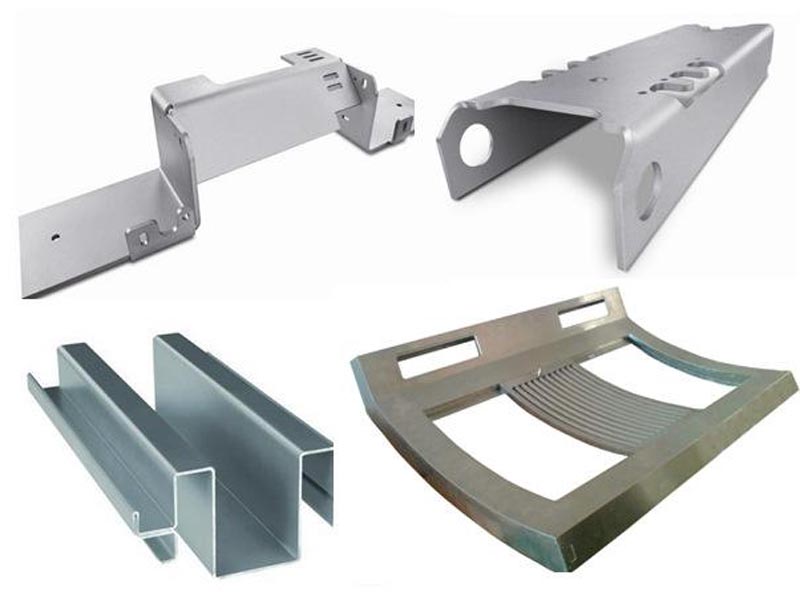
1. Sheet blanking
The CNC punch press is affected by the tool. For the processing of some special-shaped workpieces and irregular holes, large burrs will appear on the edges. The later deburring must be performed, and the accuracy of the workpiece will be affected to a certain extent.
Schematic diagram of punching burr section
Laser processing has no tool restriction, flat section, suitable for processing special-shaped workpieces, but it takes a long time to process small workpieces. Place the worktable next to the CNC and the laser, which is conducive to placing the sheet on the machine for processing and reducing the workload of lifting the board.
Some usable side materials are placed in designated places to provide materials for trial molds during bending.
2. Familiar with drawings
The sheet metal processing is based on the drawings, according to the different unfolded drawings and batches, choose different blanking methods, including laser, CNC punching, shearing, molds, etc., and then make the corresponding unfold according to the drawings.
3. Bending
When bending, you must first determine the tool and slot used for bending according to the size on the drawing and the thickness of the material. Avoiding deformation caused by collision between the product and the tool is the key to the selection of the upper mold (in the same product, it may be used Different types of upper mold), the selection of the lower mold is determined according to the thickness of the plate.
Secondly, determine the order of bending. The general rule of bending is first inside and then outside, first small and then big, first special and then common. The workpiece with dead edges is first bent to 30°-40°, and then the workpiece is pressed tightly with a leveling die.
4. Polishing
After the workpiece is blanked, the corners, burrs, and contacts should be trimmed (grinding) as necessary. The tool contacts should be trimmed with a flat file. For workpieces with larger burrs, a grinder should be used to trim the contact points. Use the corresponding small file to trim to ensure the beautiful appearance. At the same time, the trimming of the shape also ensures the positioning during bending, so that the position of the workpiece on the bending machine during bending is consistent, and the size of the same batch of products is consistent.
After the blanking is completed, enter the next process, and different workpieces enter the corresponding process according to the processing requirements. There are bending, pressure riveting, flanging tapping, spot welding, convex hull, and segment difference. Sometimes the nut or stud should be pressed after one or two bends. Among them, the convex hull and segment difference of the mold should be considered. Process first, so as to avoid interference in other processes after processing first, and the required processing cannot be completed. When there are hooks on the upper cover or lower shell, if they cannot be touch-welded after bending, they must be processed before bending.
5. Welding
Welding includes argon arc welding, spot welding, carbon dioxide shielded welding, manual arc welding, etc. Spot welding must first consider the position of the workpiece, and consider positioning tooling to ensure the accuracy of the spot welding position during mass production. In order to weld firmly, make bumps on the workpiece to be welded. The bumps can be evenly contacted with the plate before energized welding, so as to ensure that the heating of each point is consistent, and the welding position can also be determined. Similarly, welding is required. Adjust the preload time, holding time, maintenance time, and rest time to ensure that the workpiece can be spot welded firmly.
After spot welding, there will be welding scars on the surface of the workpiece, which should be processed by a flat grinder. Sub-arc welding is mainly used when two large workpieces are connected together, or the corners of a workpiece are treated to achieve a smooth surface of the workpiece ,smooth. The heat generated during sub-arc welding is easy to deform the workpiece. After welding, it must be treated with a grinder and a flat grinder, especially in the corners.
In addition to the strict requirements in the production process, the quality of sheet metal parts requires a quality inspection independent of the production. One is to strictly check the size according to the drawings, and the other is to strictly check the appearance quality. If the size does not match, it will be repaired or scrapped. The appearance is not It is allowed to check the color difference, corrosion resistance and adhesion after spraying. In this way, you can find errors in unfolding drawings, bad habits in the process, and errors in the process, such as programming errors in the number of punches, and mold errors.
6. Pressure riveting
When riveting, consider the height of the studs and choose the same and different molds, and then adjust the pressure of the press to ensure that the studs are flush with the surface of the workpiece, and avoid the studs from not being pressed firmly or pressing out beyond the workpiece surface, causing the workpiece scrapped.
Get your Sheet Metal machining projects started today
When you send out 3D CAD documents to us, JY Machinery will provide you with instant price, on-demand delivery time, as well as design for manufacturability comments for your customized CNC machining components on materials and also producing process, to make sure that the component can meet your expectations as well as budget plan demands.
Get in touch with us today for a free quote!
Skype: Chat on Skype
Email: info@jycncmachining.com
Phone: +86 15905915652